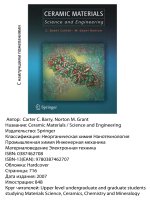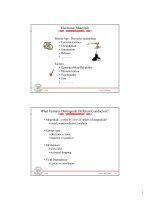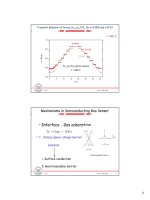supercritical fluid technology in materials science and engineering
Bạn đang xem bản rút gọn của tài liệu. Xem và tải ngay bản đầy đủ của tài liệu tại đây (5.77 MB, 578 trang )
Marcel Dekker, Inc. New York
•
Basel
TM
SUPERCRITICAL FLUID
TECHNOLOGY IN MATERIALS
SCIENCE AND ENGINEERING
SYNTHESES, PROPERTIES, AND APPLICATIONS
EDITED BY
YA-PING SUN
Clemson University
Clemson, South Carolina
Copyright 2002 by Marcel Dekker. All Rights Reserved.
ISBN: 0-8247-0651-X
This book is printed on acid-free paper.
Headquarters
Marcel Dekker, Inc.
270 Madison Avenue, New York, NY 10016
tel: 212-696-9000; fax: 212-685-4540
Eastern Hemisphere Distribution
Marcel Dekker, Inc.
Hutgasse 4, Postfach 812, CH-4001 Basel, Switzerland
tel: 41-61-261-8482; fax: 41-61-261-8896
World Wide Web
The publisher offers discounts on this book when ordered in bulk quantities. For more
information, write to Special Sales/Professional Marketing at the headquarters address
above.
Copyright © 2002 by Marcel Dekker, Inc. All Rights Reserved.
Neither this book nor any part may be reproduced or transmitted in any form or by any
means, electronic or mechanical, including photocopying, microfilming, and recording,
or by any information storage and retrieval system, without permission in writing from
the publisher.
Current printing (last digit):
10987654321
PRINTED IN THE UNITED STATES OF AMERICA
Copyright 2002 by Marcel Dekker. All Rights Reserved.
Preface
Supercritical fluid technology has attracted the attention of both scientists and
engineers. In the last 20 years or so, applications of supercritical fluid technol-
ogy have been primarily in extraction and chromatography. Extensive experi-
mental and theoretical investigations have been aimed toward an understanding
of the properties of supercritical fluid systems, particularly intermolecular inter-
actions (solute–solvent, solvent–solvent, and solute–solute) in supercritical fluid
solutions. Recently, however, significant progress has been made in the use of
supercritical fluids and mixtures as reaction media for chemical syntheses and
polymer preparations and as alternative solvent systems for materials process-
ing. In fact, materials-related applications have emerged as a new frontier in
the development of supercritical fluid technology. I hope that this book will be
a timely contribution to this emerging research field by serving at least two
purposes. One is to provide interested readers with a rich source of information
on the current status of supercritical fluid technology as related to materials
research. The second is to stimulate more interest within the multidisciplinary
supercritical fluid research community for the further development of the tech-
nology in materials-related applications.
I would like to thank all the contributors. I also thank my students and
postdoctoral associates; together we have had a lot of fun in the pursuit of
many interesting and exciting projects in this research field. I am grateful for
financial support from the National Science Foundation and the U.S. Department
of Energy during my editing of this book.
On a more personal note, I want to credit Professor Wen-Hsing Yen, on
the occasion of his 95th birthday celebration, for introducing me to the world of
chemical thermodynamics and the critical phenomenon, at Zhejiang University
Copyright 2002 by Marcel Dekker. All Rights Reserved.
in China many years ago. Credit is also due my postdoctoral mentor Professor
Marye Anne Fox. It was her collaboration with Professor Keith Johnston at the
University of Texas at Austin that introduced me to the field of supercritical
fluid research.
Ya-Ping Sun
Copyright 2002 by Marcel Dekker. All Rights Reserved.
Contents
Preface
Contributors
1. Fundamental Properties of Supercritical Fluids
Christopher E. Bunker, Harry W. Rollins, and Ya-Ping Sun
2. NMR Investigation of High-Pressure, High-Temperature
Chemistry and Fluid Dynamics
Clement R. Yonker and Markus M. Hoffmann
3. Organic Chemical Reactions and Catalysis in Supercritical
Fluid Media
Keith W. Hutchenson
4. Homogeneous Catalysis in Supercritical Carbon Dioxide
Can Erkey
5. Supercritical Fluid Processing of Polymeric Materials
Mark A. McHugh, J. Don Wang, and Frederick S. Mandel
6. Surfactants in Supercritical Fluids
Janice L. Panza and Eric J. Beckman
7. In Situ Blending of Electrically Conducting Polymers in
Supercritical Carbon Dioxide
Amyn S. Teja and Kimberly F. Webb
Copyright 2002 by Marcel Dekker. All Rights Reserved.
8. Hydrothermal Synthesis of Metal Oxide Nanoparticles
Under Supercritical Conditions
Tadafumi Adschiri and Kunio Arai
9. Production of Magnetic Nanoparticles Using
Supercritical Fluids
Amyn S. Teja and Linda J. Holm
10. Metal Processing in Supercritical Carbon Dioxide
Chien M. Wai
11. Understanding the RESS Process
Markus Weber and Mark C. Thies
12. Pharmaceutical and Biological Materials Processing with
Supercritical Fluids
Srinivas Palakodaty, Peter York, Raymond Sloan, and
Andreas Kordikowski
13. Preparation and Processing of Nanoscale Materials by
Supercritical Fluid Technology
Ya-Ping Sun, Harry W. Rollins, Jayasundera Bandara,
Jaouad M. Meziani, and Christopher E. Bunker
Copyright 2002 by Marcel Dekker. All Rights Reserved.
Contributors
Tadafumi Adschiri, Ph.D. Department of Chemical Engineering, Tohoku Uni-
versity, Sendai, Japan
Kunio Arai, Ph.D. Department of Chemical Engineering, Tohoku University,
Sendai, Japan
Jayasundera Bandara, Ph.D. Department of Chemistry, Clemson University,
Clemson, South Carolina
Eric J. Beckman, Ph.D. Department of Chemical Engineering, University of
Pittsburgh, Pittsburgh, Pennsylvania
Christopher E. Bunker, Ph.D. Propulsion Directorate, Air Force Research
Laboratory, Wright-Patterson Air Force Base, Ohio
Can Erkey, Ph.D. Department of Chemical Engineering, University of Con-
necticut, Storrs, Connecticut
Markus M. Hoffmann, Ph.D. Department of Chemistry, State University of
New York–Brockport, Brockport, New York
Linda J. Holm, Ph.D. School of Chemical Engineering, Georgia Institute of
Technology, Atlanta, Georgia
Keith W. Hutchenson, Ph.D. Central Research and Development, DuPont
Company, Wilmington, Delaware
Copyright 2002 by Marcel Dekker. All Rights Reserved.
Andreas Kordikowski, Dr.rer.nat. Technology Development, Bradford Parti-
cle Design plc, Bradford, West Yorkshire, England
Frederick S. Mandel, Ph.D. Department of Chemical Engineering, Virginia
Commonwealth University, Richmond, Virginia
Mark A. McHugh, Ph.D. Department of Chemical Engineering, Virginia
Commonwealth University, Richmond, Virginia
Jaouad M. Meziani, Ph.D. Department of Chemistry, Clemson University,
Clemson, South Carolina
Srinivas Palakodaty, Ph.D. Process Engineering, Bradford Particle Design
plc, Bradford, West Yorkshire, England
Janice L. Panza, Ph.D. Department of Chemical and Petroleum Engineering,
University of Pittsburgh, Pittsburgh, Pennsylvania
Harry W. Rollins, Ph.D. Chemistry Department, Idaho National Engineering
and Environmental Laboratory, Idaho Falls, Idaho
Raymond Sloan, Ph.D. Bioprocessing Department, Bradford Particle Design
plc, Bradford, West Yorkshire, England
Ya-Ping Sun, Ph.D. Department of Chemistry, Clemson University, Clemson,
South Carolina
Amyn S. Teja, Ph.D. School of Chemical Engineering, Georgia Institute of
Technology, Atlanta, Georgia
Mark C. Thies, Ph.D. Department of Chemical Engineering, Clemson Uni-
versity, Clemson, South Carolina
Chien M. Wai, Ph.D. Department of Chemistry, University of Idaho, Moscow,
Idaho
J. Don Wang, Ph.D. Consultant, Supercritical Fluid Development, Cleveland,
Ohio
Kimberly F. Webb, Ph.D. School of Chemical Engineering, Georgia Institute
of Technology, Atlanta, Georgia
Copyright 2002 by Marcel Dekker. All Rights Reserved.
Markus Weber, Dr.sc.techn. Department of Chemical Engineering, Clemson
University, Clemson, South Carolina
Clement R. Yonker, Ph.D. William R. Wiley Laboratory, Pacific Northwest
National Laboratory, Richland, Washington
Peter York, Ph.D., F.R.S.C., C.Chem. School of Pharmacy, University of
Bradford, Bradford, West Yorkshire, England
Copyright 2002 by Marcel Dekker. All Rights Reserved.
1
Fundamental Properties of
Supercritical Fluids
Christopher E. Bunker
Wright-Patterson Air Force Base, Ohio
Harry W. Rollins
Idaho National Engineering and Environmental Laboratory, Idaho Falls, Idaho
Ya-Ping Sun
Clemson University, Clemson, South Carolina
I. INTRODUCTION
Supercritical fluids
∗
have been studied extensively for the past two decades in at-
tempts to gain accurate and detailed knowledge of their fundamental properties.
Such knowledge is essential to the utilization and optimization of supercritical
fluid technology in materials preparation and processing. Among the most im-
portant properties of a supercritical fluid are the low and tunable densities that
can be varied between those of a gas and a normal liquid and the local density
effects observed in supercritical fluid solutions (most strongly associated with
near-critical conditions). A supercritical fluid may be considered macroscopi-
cally homogeneous but microscopically inhomogeneous, consisting of clusters
of solvent molecules and free volumes. That a supercritical fluid is macroscop-
ically homogeneous is obvious—the fluid at a temperature above the critical
temperature exists as a single phase regardless of pressure. As a consequence,
∗
A supercritical fluid is defined loosely as a solvent above its critical temperature because under those
conditions the solvent exists as a single phase regardless of pressure. It has been demonstrated that
a thorough understanding of the low-density region of a supercritical fluid is required to obtain a
clear picture of the microscopic properties of the fluid across the entire density region from gas-like
to liquid-like (1–3).
Copyright 2002 by Marcel Dekker. All Rights Reserved.
extremely wide variations in the solvent properties may be achieved. The mi-
croscopic inhomogeneity of a supercritical fluid is a more complex issue and
is probably dependent on the density of the fluid. The microscopic properties
and their effects on and links to the macroscopic properties have been the focus
of numerous experimental investigations, many of which employed molecular
spectroscopic techniques. The main issues have been the existence and extent of
local density augmentation (or solute–solvent clustering) and solvent-facilitated
solute concentration augmentation (or solute-solute clustering) in supercritical
fluid solutions.
Solute–solvent clustering is typically defined as a local solvent density
about a solute molecule that is greater than the bulk solvent density in a su-
percritical fluid solution. Initially, local density augmentation was proposed to
explain the unusual density dependence of the basic solvent parameters (i.e.,
polarity, dielectric constant, refractive index, viscosity, etc.). These early stud-
ies tended to demonstrate significant discrepancies between experimental results
and those predicted by continuum theory. It is now known that for different
supercritical fluids a common pattern exists for the density dependence of the
solute–solvent interactions. The pattern is characterized by different spectro-
scopic (or other) responses in the three density regions: (a) a rapid increase in
response in the low-density region; (b) a plateau-like response in the near-critical
density region; and (c) a further increase in response in the high-density region
(Figure 1) (1–3). This characteristic pattern is a reflection of the specific solute–
solvent interactions occurring in the three density regions. Thus, an empirical
Figure 1 Cartoon representation of typical spectroscopic and other responses in the
three density regions in a supercritical fluid.
Copyright 2002 by Marcel Dekker. All Rights Reserved.
three-density-region solvation model has been developed to serve as a baseline
in the interpretation of supercritical fluid properties (1–3).
Solute-solute clustering is somewhat less well defined. As an extension
of the concept of solute–solvent clustering, the type of solute-solute clustering
commonly discussed in the literature may be defined loosely as local solute
concentrations that are greater than the bulk solute concentration. An important
consequence of solute-solute clustering is the enhancement of bimolecular reac-
tions in supercritical fluid solutions. Thus, well-established bimolecular probes
(most commonly intermolecular reactions or intramolecular reactive molecules)
have been used in the study of the clustering phenomenon. Experimental re-
sults that confirm and others that deny the existence of significant solute–solute
clustering in supercritical fluid solutions have been presented, and some inter-
pretations remain controversial. That solute–solute clustering is probably system
dependent makes the issue more complex. Nevertheless, a critical review of the
available evidence and various opinions on the issue is warranted.
On the topics of solute–solvent and solute-solute clustering, there is a
significant number of publications by research groups from around the world,
demonstrating the tremendous interest of the international research community.
This chapter is a review of representative literature results, especially those based
on molecular spectroscopy and related experimental techniques. Discussion of
the fundamental properties of supercritical fluids will be within the context of
enhanced solute–solvent and solute–solute interactions in supercritical fluid so-
lutions, and the current understanding of the reasonably well-established solute–
solvent clustering model and the somewhat controversial solute-solute clustering
concept will be presented.
II. SOLUTE–SOLVENT INTERACTIONS
Numerous experimental studies have been conducted on solute–solvent inter-
actions in supercritical fluid solutions. In particular, issues such as the role of
characteristic supercritical solvent properties in solvation and the dependence of
solute–solvent interactions on the bulk supercritical solvent density have been
extensively investigated. Results from earlier experiments showed that the par-
tial molar volumes υ
2
became very large and negative near the critical point of
the solvent (4–12). The results were interpreted in terms of a collapse of the
solvent about the solute under near-critical solvent conditions, which served as
a precursor for the solute–solvent clustering concept. Molecular spectroscopic
techniques, especially ultraviolet-visible (UV-vis) absorption and fluorescence
emission, have since been applied to the investigation of solute–solvent interac-
tions in supercritical fluid solutions. Widely used solvent environment–sensitive
molecular probes include Kamlet–Taft π
∗
scale probes for polarity/polarizability
Copyright 2002 by Marcel Dekker. All Rights Reserved.
(13,14), pyrene (Py scale) (15,16), solvatochromic organic dyes, and molecules
that undergo twisted intramolecular charge transfer (TICT) in the photoexcited
state (17).
A. Kamlet-Taft
∗
Scale for Polarity/Polarizability
The π
∗
scale of solvent polarity/polarizability is based on the correlation be-
tween the experimentally observed absorption or emission shifts (ν
max
values) of
various nitroaromatic probe molecules and the ability of the solvent to stabilize
the probe’s excited state via dielectric solute–solvent interactions (18). Since π
∗
values are known for many commonly used liquid solvents, the π
∗
scale allows
comparison of the solvation strength of supercritical fluids and normal liquid
solvents. Several research groups have utilized the π
∗
probes to investigate sol-
vent characteristics for a series of supercritical fluids (19–34). For example,
Hyatt (19) employed two nitroaromatic dyes and the penta-tert-butyl variation
of the Riechardt dye (18) to determine the π
∗
values in liquid and supercritical
CO
2
(0.7 reduced density at 41
◦
C). The experimental results were also used
to calculate the E
T
(30) solvent polarity scale (19), which is similar to the π
∗
scale.
∗
The π
∗
values obtained in both liquid (−0.46) and supercritical CO
2
(−0.60) were much lower than that of liquid hexane (−0.08), whereas the
E
T
(30) value (33.8 kcal/mol) compared well with those of simple aromatic
hydrocarbons such as toluene (33.9 kcal/mol). Sigman et al. determined the π
∗
values for 10 different nitroaromatic dyes in supercritical CO
2
at several den-
sities (20,21). For temperatures between 36
◦
C and 42
◦
C, the π
∗
values varied
between −0.5 and −0.1 over the CO
2
density range ∼0.4–0.86 g/mL (reduced
density 0.87–1.87). These π
∗
values place the solvent strength of high-density
supercritical CO
2
near that of liquid hexane (−0.08). The results also show
that the solvent strength of supercritical CO
2
increases with increasing density.
Hyatt’s results for the infrared absorption spectral shifts of the C=O stretch of
acetone and cyclohexanone and the N-H stretch of pyrrole in liquid and super-
critical CO
2
are also consistent with the conclusion that supercritical CO
2
is
near to liquid hexane in solvent strength (19).
A more detailed examination of the density dependence of the π
∗
values
was performed by Yonker et al. and Smith et al. using primarily 2-nitroanisole
as probe in sub- and supercritical CO
2
,N
2
O, CClF
3
,NH
3
, ethane, Xe, and
∗
The E
T
(30) solvent polarity scale is based on the spectral shift of a betaine dye (Riechardt dye)
in a large number of solvents and correlates the dye’s spectral shift to the ability of the solvent to
stabilize the probe molecule via dielectric solute–solvent interactions (18). The E
T
(30) scale has
found limited application in the investigation of supercritical fluids, mainly because of solubility
issues.
Copyright 2002 by Marcel Dekker. All Rights Reserved.
Structure 1
Copyright 2002 by Marcel Dekker. All Rights Reserved.
Structure 1 (Continued)
Copyright 2002 by Marcel Dekker. All Rights Reserved.
SF
6
(22–25). Under subcritical (liquid) conditions, a wide variation in π
∗
was
found among the solvents: 0.8 (NH
3
), 0.04 (CO
2
), −0.03 (N
2
O), −0.21 (CClF
3
),
−0.22 (ethane), and −0.36 (SF
6
) (22,23). These π
∗
values correlate well with
the Hildebrand solubility parameters of the solvents. The same variation in π
∗
was observed for the solvents under supercritical conditions when compared at
a single reduced density (Figure 2) (22). For a given supercritical fluid, the π
∗
values were again found to increase with increasing fluid density; however, the
solvent strength was clearly nonlinear with density, especially in the low-density
region (Figure 2). This was particularly true for supercritical CO
2
, ethane, and
Xe, for which characteristic three-density-region solvation model behavior was
observed. The apparent linear dependence of the π
∗
values on fluid density in
supercritical NH
3
and SF
6
was attributed to specific solute–solvent interactions
that represent the two extremes—unusually high polarity in NH
3
and a general
lack of sensitivity due to the nonpolar nature of SF
6
(22).
Kim and Johnston made a similar observation of nonlinear density de-
pendence for the shift in the absorption spectral maximum of phenol blue in
Figure 2 Plot of π
∗
vs. reduced density (ρ/ρ
c
) for the five fluids. (From Ref. 22.)
Copyright 2002 by Marcel Dekker. All Rights Reserved.
supercritical ethylene, CClF
3
, and fluoroform (26). Quantitatively, the stabiliza-
tion of the photoexcited probe molecule in solution is linearly related to the
intrinsic solvent strength, E
0
T
.
E
0
T
= A[(n
2
− 1)/(2n
2
+ 1)]
+ B[(ε − 1)/(ε + 2) − (n
2
− 1)/(n
2
+ 2)]+C (1)
where A, B, and C are constants specific to the solvent, n is the solvent re-
fractive index, and ε is the solvent dielectric constant. According to Kim and
Johnston (26), the plot of the absorption spectral maximum of phenol blue vs.
E
0
T
deviates from the linear relationship [Eq. (1)] in the near-critical density
region; this deviation can be attributed to the clustering of solvent molecules
about the solute probe (Figure 3).
A similar deviation was observed by Yonker et al. in the plot of π
∗
values
as a function of the first term in Eq. (1), (n
2
− 1)/(2n
2
+ 1); the deviation was
also discussed in terms of solute–solvent clustering (Figure 4) (23–25).
The use of similar molecular probes in various supercritical fluids has been
reported (27–34), e.g., 9-(α-perfluoroheptyl-β,β-dicyanovinyl)julolidine dye for
supercritical ethane, propane, and dimethyl ether (27); nile red dye for 1,1,1,2-
tetrafluoroethane (28); 4-nitroanisole and 4-nitrophenol for ethane and fluori-
nated ethanes (29); 4-aminobenzophenone for fluoroform and CO
2
(30); phenol
blue for CO
2
, CHF
3
,N
2
O, and ethane (31); and coumarin-153 dye for CO
2
,
Figure 3 Transition energy (E
T
) and isothermal compressibility vs. density for phenol
blue in ethylene: (᭺)25
◦
C, (᭝)10
◦
C, (–––) calculated E
0
T
. (From Ref. 26.)
Copyright 2002 by Marcel Dekker. All Rights Reserved.
Figure 4 π
∗
vs. Onsager reaction field function (L(n
2
)) for CO
2
at 50
◦
C. (From
Ref. 23.)
fluoroform, and ethane (32,33). The results of these studies showed the char-
acteristic density dependence of solvation in supercritical fluids, supporting the
solute–solvent clustering concept.
B. Pyrene and the Py Scale
The molecular probe pyrene is commonly employed to elucidate solute–solvent
interactions in normal liquids (18,35). Because of the high molecular symmetry,
the transition between the ground and the lowest excited singlet state is only
weakly allowed, subject to strong solvation effects (36–39). As a result, in the
fluorescence spectrum of pyrene the relative intensities of the first (I
1
) and third
(I
3
) vibronic bands vary with changes in solvent polarity and polarizability. The
ratio I
1
/I
3
serves as a convenient solvation scale, often referred to as the Py
solvent polarity scale. Py values for an extensive list of common liquid solvents
have been tabulated (15,16).
Structure 2
Copyright 2002 by Marcel Dekker. All Rights Reserved.
Several research groups have used pyrene as a fluorescent probe in the
study of supercritical fluid properties (2,3,40–48). In particular, the density de-
pendence of the Py scale has been examined systematically in a number of
supercritical fluids such as CO
2
(2,3,40–43,45,46), ethylene (40,41,47), fluoro-
form (3,40,41,43,47), and CO
2
-fluoroform mixtures (43). The Py values obtained
in various supercritical fluids correlate well with the polarity or polarizability
parameters of the fluids (3,40,41,43,47). For example, Brennecke et al. (40)
found that the Py values obtained in fluoroform were consistently larger than
those obtained in CO
2
, which were, in turn, consistently larger than those found
in ethylene over the entire density region examined. In addition, the Py values
obtained in the liquid-like region (reduced density ∼1.8) indicate that the lo-
cal polarity of fluoroform is comparable to that of liquid methanol, CO
2
with
xylenes, and ethane with simple aliphatic hydrocabons (15,16).
For the density dependence of solute–solvent interactions in supercritical
fluids, the Py values were found to increase with increasing density in a nonlinear
manner (2,3,40–43). For example, Sun et al. reported Py values in supercritical
CO
2
over the reduced density (ρ
r
) range 0.025–1.9 at 45
◦
C (Figure 5) (2). At
low densities (ρ
r
< 0.5), the Py values are quite sensitive to density changes,
increasing rapidly with increasing density. However, at higher densities, the Py
values exhibit little variation with density over the ρ
r
range ∼0.5–∼1.5, followed
by slow increases with density at ρ
r
> 1.5. The nonlinear density dependence
was attributed to solvent clustering effects in the near-critical region of the
Figure 5 Py values in the vapor phase () and CO
2
at 45
◦
C with excitation at 314 nm
(᭺) and 334 nm (᭝). (From Ref. 2.)
Copyright 2002 by Marcel Dekker. All Rights Reserved.
supercritical fluid. Quantitatively, the clustering effects were evaluated using the
dielectric cross-term f(ε,n
2
) (2):
f(ε,n
2
) =[(ε − 1)/(2ε + 1)]∗[(n
2
− 1)/(2n
2
+ 1)] (2)
Extrapolation of the data obtained in the liquid-like region to the gas-phase
values confirmed that significant deviation of the experimental data from the
prediction of Eq. (2) for the low-density region of supercritical CO
2
was occur-
ring (Figure 6). The results are consistent with those obtained from investigations
using other polarity-sensitive molecular probes. It appears that the largest devi-
ation (or the maximum clustering effect) occurs at a reduced density of about
0.5 rather than at the critical density, as was naturally assumed (40,42,43).
The investigation of high-critical-temperature supercritical fluids is a more
challenging task. One of the significant difficulties associated with these stud-
ies is probe-molecule thermal stability; many molecular probes commonly used
with ambient supercritical fluids decompose at the temperatures required by
these high-critical-temperature fluids. Fortunately, pyrene can be employed for
such tasks. Several reports have been made of the use of pyrene as a molecu-
lar probe to investigate solute–solvent interactions in high-critical-temperature
supercritical fluids (e.g., pentane, hexane, heptane, octane, cyclohexane, meth-
cyclohexane, benzene, toluene, and water) (44,48,49). In supercritical hexane
Figure 6 Py values in CO
2
at 45
◦
C plotted against a dielectric cross term f(ε,n
2
).
The line, Py = 0.48 + 0.02125 f(ε,n
2
), is a reference relationship for the calculation
of local densities. (From Ref. 2.)
Copyright 2002 by Marcel Dekker. All Rights Reserved.
Figure 7 Pyrene fluorescence excitation spectral shifts (᭺), and hexane C-H Raman
shifts (ᮀ) and Raman intensities (᭞) in supercritical hexane at 245
◦
C. The y axis repre-
sents normalized spectral responses, with Z
G
being the spectral response obtained in the
gas phase, Z
C
the spectral response at the critical density, and Z the observed responses.
(From Ref. 49).
the pyrene fluorescence spectrum is very broad, lacking the characteristic struc-
tural detail observed in the room-temperature spectrum (49). The fluorescence
spectrum for low and high densities is essentially the same; however, the fluo-
rescence excitation spectrum maintains its characteristic vibronic structure and
displays a small but measurable red shift with increasing fluid density (49). A
plot of the fluorescence excitation spectral maximum as a function of the re-
duced density of supercritical hexane (Figure 7) shows the same characteristic
pattern observed for pyrene in supercritical CO
2
(2,3); and the results can be
explained in terms of the three-density-region solvation model (1–3). It appears
that even in the high-temperature supercritical fluids, solute–solvent clustering is
prevalent. This is supported by results obtained from the investigation of super-
critical hexane using Raman spectroscopy, where the spectral shifts and relative
intensities of the C-H stretch transition of hexane were measured at different
densities (Figure 7) (49).
C. TICT State Probes
Molecules that form a TICT state serve as excellent probes to elucidate solute–
solvent interactions in condensed media (17). Upon photoexcitation, the excited-
state processes of TICT molecules in polar solvents are characterized by a ther-
Copyright 2002 by Marcel Dekker. All Rights Reserved.
modynamic equilibrium between the locally excited (LE) singlet state and the
TICT state (Figure 8) (50). Because of the two excited states, TICT molecules
often exhibit dual fluorescence, with the fluorescence band due to the TICT
state being extremely sensitive to solvent polarity. The spectral shifts of the
TICT emission band can be used to establish a polarity scale similar to the Py
and π
∗
scales.
Structure 3
Kajimoto et al. used the classic TICT molecule p-(N ,N-dimethylamino)
benzonitrile (DMABN) to investigate solute–solvent interactions in supercritical
fluoroform (51–54) and ethane (55). In fluoroform, the TICT emission was
readily observed. The emission band shifted to the red with increasing fluoroform
density. The shift was accompanied by an increase in the relative contribution
of the TICT emission to the observed total fluorescence (Figure 9) (51). The
solvent effects were evaluated by plotting the shift in the TICT band maximum
as a function of the dielectric cross-term [Eq. (2)]:
P =[(ε − 1)/(ε + 2)]−[(n
2
− 1)/(n
2
+ 2)] (3)
The shifts of the TICT band maximum in normal liquid solvents correlated
well with those of P , confirming the linear relationship predicted by classi-
cal continuum theory. However, the results in supercritical fluoroform deviated
Copyright 2002 by Marcel Dekker. All Rights Reserved.
Figure 8 Energy diagram for the formation and decay of a TICT state in DEAEB and
related molecules. The coordinate is for the twisting of amino-phenyl linkage. The dia-
gram represents a mechanism in which fast and slow emission processes are considered.
The fast process is restricted in the region surrounded by dashed lines. (From Ref. 50.)
significantly from the relationship, indicating that the effective polarities in su-
percritical fluoroform were significantly larger than expected (Figure 10) (51).
According to Kajimoto et al. (51), the deviation may be attributed to unusual
solute–solvent interactions (or solute–solvent clustering) in supercritical fluid
solutions. From the results at low fluid densities, they were able to determine
the number of solvent molecules about the solute using a simple model with
solute–solvent interaction potentials (51,52,54,55).
Sun et al. carried out a more systematic investigation of the TICT molecules
DMABN and ethyl p-(N,N-dimethylamino)benzoate (DMAEB) in supercritical
fluoroform, CO
2
, and ethane as a function of fluid density (1). They found
that the absorption and TICT emission spectral maxima shifted to the red with
increasing fluid density. The results were comparable to those reported by Ka-
jimoto et al. (51–55). More importantly, the spectral shifts and the fractional
contribution of the TICT state emission changed with fluid density following the
characteristic three-density-region pattern (Figures 11 and 12) (1). In fact, these
results furnished the impetus for the development of the three-density-region sol-
vation model for solute–solvent interactions in supercritical fluid solutions (2,3).
Copyright 2002 by Marcel Dekker. All Rights Reserved.
Figure 9 Dependence of the relative intensity of the CT emission of DMABN on the
density of the supercritical solvent, CF
3
H (in g/mL). (From Ref. 51.)
Another TICT molecule, ethyl p-(N ,N-diethylamino)benzoate (DEAEB),
was used to probe solute–solvent interactions in supercritical ethane, CO
2
, and
fluoroform (3,50,56). Unlike DMABN and DMAEB, DEAEB forms a TICT
state even in nonpolar solvents (Figure 13) (50), resulting in dual fluorescence
emissions. Because of the excited-state thermodynamic equilibrium, the relative
intensities (or fluorescence quantum yields) of the LE-state (x
LE
) and TICT-state
(x
TICT
) emissions may be correlated with the enthalpy (H ) and entropy (S)
differences between the two excited states:
K = (x
TICT
/x
LE
)(k
F,LE
)/(k
F,TICT
) (4)
ln(x
TICT
/x
LE
) =−H/RT + S/R + ln[(k
F,TICT
)/(k
F,LE
)] (5)
where k
F,LE
and k
F,TICT
are the radiative rate constants of the two excited states.
If solvent effects on the entropy difference are assumed to be negligible, the
relative contributions of the LE-state and TICT-state emissions are dependent
primarily on the enthalpy difference H . The energy gap between the two ex-
cited states is obviously dependent on solvent polarity because the highly polar
TICT state is more favorably solvated than the LE state in a polar or polarizable
solvent environment. Thus, ln(x
TICT
/x
LE
) serves as a sensitive measure for the
solvent-induced stabilization of the TICT state (Figure 14) (3). For DEAEB in
the supercritical fluids (ethane in particular), the LE and TICT emission bands
Copyright 2002 by Marcel Dekker. All Rights Reserved.
Figure 10 Shift of the maximum of the CT emission as a function of the polar param-
eter of the solvent. The open circle shows the data obtained in the liquid solvent: (1) bro-
mobenzene, (2) n-butyl chloride, (3) THF, (4) butylnitrile, (5) cyclohexanol, (6) ethanol,
and (7) methanol. The solid circles represent the results of the supercritical experiments.
The polar parameters for the supercritical fluid were calculated based on the reported
dielectric constants. (From Ref. 51.)
overlap significantly. A quantitative determination of the x
TICT
/x
LE
ratio as a
function of the fluid density requires the separation of overlapping fluorescence
spectral bands. In the work of Sun et al. (50,56), the spectral separation was
aided by the application of a chemometric method known as principal com-
ponent analysis—self-modeling spectral resolution (57–62). As shown in Fig-
ure 14, the plot of ln(x
TICT
/x
LE
) as a function of reduced density in supercritical
ethane again shows the characteristic three-density-region pattern, which vali-
dates the underlying concept of the three-density-region solvation model for
solute–solvent interactions in supercritical fluid solutions.
Other investigations of supercritical fluid systems have been conducted
using TICT and TICT-like molecules as probes. For example, DMABN and
DMAEB were used to study solvation in two-component supercritical fluid
mixtures (63). Another popular probe has been the highly fluorescent molecule
Copyright 2002 by Marcel Dekker. All Rights Reserved.









